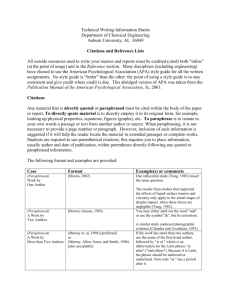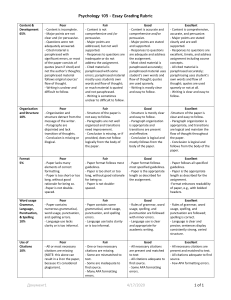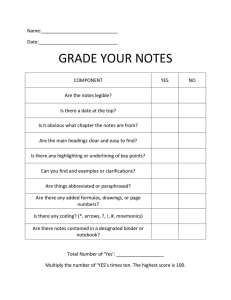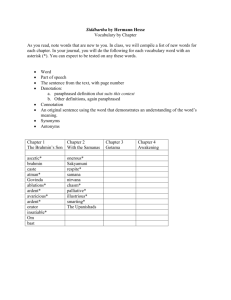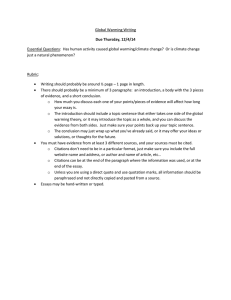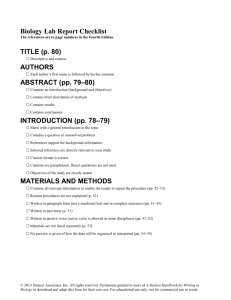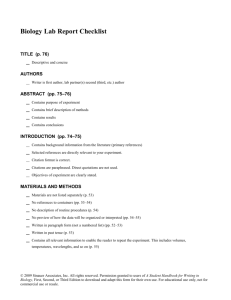Technical Writing Information Sheets Department of Chemical Engineering
advertisement
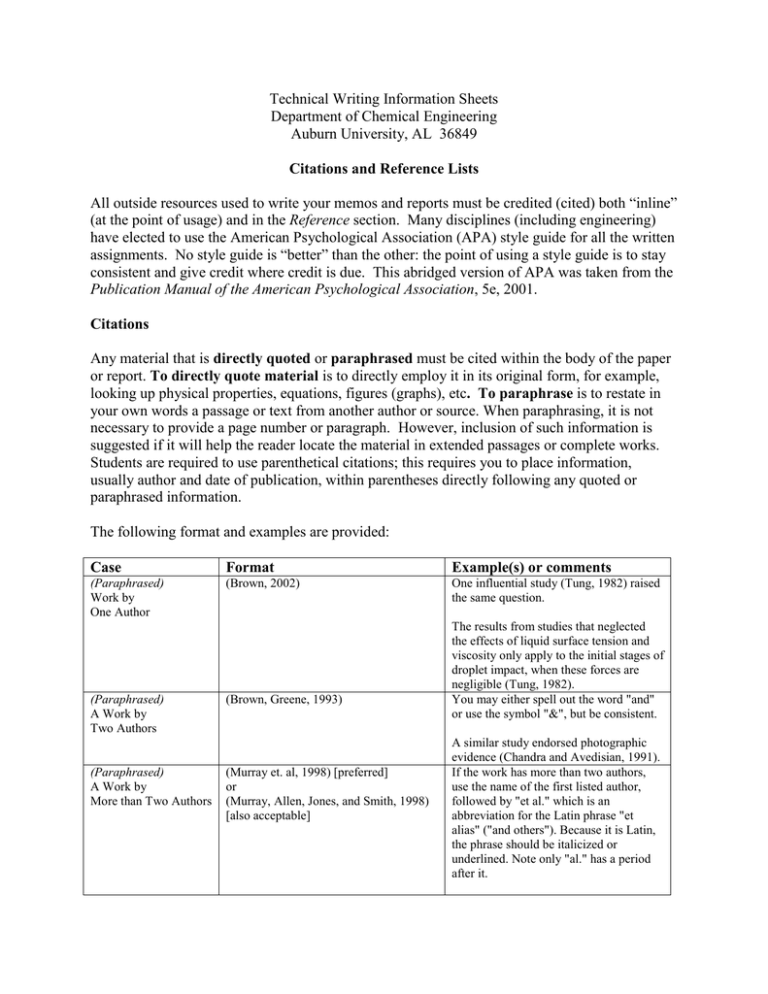
Technical Writing Information Sheets Department of Chemical Engineering Auburn University, AL 36849 Citations and Reference Lists All outside resources used to write your memos and reports must be credited (cited) both “inline” (at the point of usage) and in the Reference section. Many disciplines (including engineering) have elected to use the American Psychological Association (APA) style guide for all the written assignments. No style guide is “better” than the other: the point of using a style guide is to stay consistent and give credit where credit is due. This abridged version of APA was taken from the Publication Manual of the American Psychological Association, 5e, 2001. Citations Any material that is directly quoted or paraphrased must be cited within the body of the paper or report. To directly quote material is to directly employ it in its original form, for example, looking up physical properties, equations, figures (graphs), etc. To paraphrase is to restate in your own words a passage or text from another author or source. When paraphrasing, it is not necessary to provide a page number or paragraph. However, inclusion of such information is suggested if it will help the reader locate the material in extended passages or complete works. Students are required to use parenthetical citations; this requires you to place information, usually author and date of publication, within parentheses directly following any quoted or paraphrased information. The following format and examples are provided: Case Format Example(s) or comments (Paraphrased) Work by One Author (Brown, 2002) One influential study (Tung, 1982) raised the same question. (Paraphrased) A Work by Two Authors (Paraphrased) A Work by More than Two Authors (Brown, Greene, 1993) (Murray et. al, 1998) [preferred] or (Murray, Allen, Jones, and Smith, 1998) [also acceptable] The results from studies that neglected the effects of liquid surface tension and viscosity only apply to the initial stages of droplet impact, when these forces are negligible (Tung, 1982). You may either spell out the word "and" or use the symbol "&", but be consistent. A similar study endorsed photographic evidence (Chandra and Avedisian, 1991). If the work has more than two authors, use the name of the first listed author, followed by "et al." which is an abbreviation for the Latin phrase "et alias" ("and others"). Because it is Latin, the phrase should be italicized or underlined. Note only "al." has a period after it. Single-shot flash photography yields better results than fast-motion movies (Akao et al. 1980) are not easily reproduced. Substitute three or four words of the title of the article, book, or Internet source. (Paraphrased) Works with No Author (“Bridges of America,” 1997) (Paraphrased) Groups or Institutions As Authors (The University of Iowa, 2002) or (Department of Human Resources [DHR], 2002) Note: (DHR, 2002) can be employed in subsequent citations after a suitable abbreviation has been established. (Paraphrased) Personal Communications (Gonzales, personal communication, May 4, 2002) (Direct Quotes) Specific Parts of the Text (printed or electronic), Quotations, Figures, and Tables (Hawkes, 1993, Chap. 2) (Ginsberg and Hawthorne, 1997, p. 232) Sometimes your sources will not be published documents, for example, if you use information from a telephone conversation, E-mail, letters, memos, and interviews. Do not include personal communications in the Reference section because the material is not “recoverable data.” If material is directly quoted, include the page or chapter where the material was retrieved. Internet source. (Sinclair, ¶ 11) In the case of Internet sources without page numbers, cite the paragraph that contains the information. Reference Lists Your second responsibility as a writer is to provide an alphabetized reference list of all in-text sources. Citing references is not mere busy work; it is your responsibility as a professional to provide readers with correct and complete access to your sources. The following guidelines will help you prepare a proper Reference list. General Formatting Guidelines for References The word “References” is typed at the top of the page and centered. Listings appear alphabetically by author’s last name or by the name of the institution or group that constitutes the author. If there is no author, the title is listed first, alphabetically by the first significant word in the title. The first line of each reference begins at the left-hand margin, and subsequent lines are indented five spaces. Material is double-spaced within and between sources. References to original sources for cited material should be listed together at the end of the paper; footnotes should not be used for this purpose. References should be arranged in numerical order according to the sequence of citations within the text. Each reference should include the last name of each author followed by his initials. References to textbooks, monographs, theses, and technical reports should include: bers of the work being cited. References to journal articles, papers in conference proceedings, or collections of works by several authors should include: ted article enclosed in quotation marks, if used. References to electronic sources, including web resources, should include: Last name of each author followed by their initials (if known). Full title of the complete work (if applicable) in italics. and the full URL. References to personal communications, including email, should include: onversation(s). Table 2 demonstrates these format issues: Table 2 – Examples of Format to be Employed with Different Reference Types Case Example(s) or comments Book: Single Author Book: Two or More Authors Book: Second or Later Edition Edited Book: Book Chapters Journal Article in Lampe, G.P. (1998). Frederick Douglass: Freedom’s voice, 1818-1845. East Lansing, MI: Michigan State University Press. Andrews, K., & Curtis, M.L. (1998). A changing Australia: The social, cultural and economic trends facing Australia. Annandale, VA: Federation. Press. Lerner, G. (1998). The Grimke sisters from South Carolina (2nd ed.). New York: Oxford University Press. Reisman S.J. (Ed.). (1962). A style manual for technical writers and editors. New York: Macmillan Baker, R.M., & Lightfoot, O.B. (1993). Psychiatric care of ethnic elders. In A.C. Gaw (Ed.), Culture, ethnicity, and mental illness (pp. 517-552). Washington, DC: American Psychiatric Press. Kauffman, J.M., & Burbach, H.J. (1998). Creating classroom civility. Education Digest, Journal Paginationed by Issue Journal Article in Journal with Continuous Pagination Magazine Article Anonymous Article Technical and Research Report Article from Internet Source Document from Internet Source (alternate) 63 (1), 12-18. Jones, P.C. (1998). Behavior modification in the classroom. Journal of Educational Psychology, 90, 60-63. Frank, A. (1997, November). Quantum honeybees. Discover, 18, 80-86. Plane soars to new heights on sunbeams. (1997, June 30). New Scientist, 130, 13. Mazzeo, J., & Druesne, B. (1991). Comparability of computer and paper-and-pencil scores for two CLEP general examinations (College Board Rep. No. 91-5). Princeton, NJ: Educational Testing Service. Hilts, P.J. (1991, February 16). In forecasting their emotions, most people flunk out. New York Times. Retrieved November 21, 2000, from http://www.nytimes.com Chou, L. & McClintock, D. (1993). Technology and education: New wine in new bottles. Retrieved September 18, 2002, from Columbia University, Institute for Learning Technologies Web site: http://www.ilt.columbia.edu/publications/papers/newwine1
